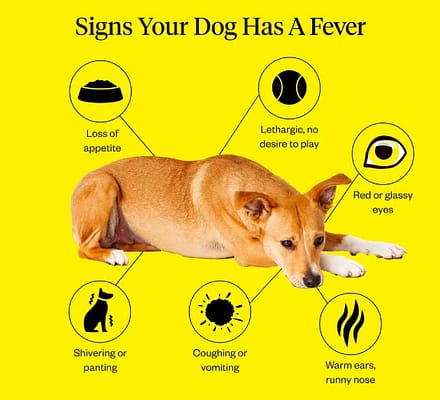Determining whether or not your beloved canine companion if dog has fever can be a challenging task. However, by employing a keen eye and astute observation skills, one can detect the subtle signs of an elevated body temperature in dogs. This article aims to provide guidance on how to identify if your dog is running a fever, ensuring their well-being and promoting optimal health.
Monitoring your dog’s temperature is paramount when it comes to detecting fever. Additionally, paying close attention to changes in behavior and appetite can offer valuable insights into their overall condition. By observing physical symptoms such as excessive panting or shivering, you may gain further evidence of an underlying fever.

While these techniques are useful for preliminary diagnosis, it is crucial to consult with a veterinarian for accurate assessment and appropriate treatment options. Their expertise will guide you through the necessary steps required in addressing your furry friend’s illness effectively.
By following the veterinarian’s advice and adhering to the prescribed treatment plan, you demonstrate your commitment towards serving your loyal companion. Together, we can ensure that our furry friends receive the care they deserve during times of illness or discomfort.
Key Takeaways
- Changes in behavior and appetite can help identify if a dog has a fever.
- Monitoring a dog’s temperature using a rectal thermometer designed for pets is crucial in detecting fever.
- Physical symptoms indicating elevated body temperature in dogs include warm ears, dry nose, lethargy, reduced appetite, shivering, and excessive panting.
- Consulting with a veterinarian is essential for accurate diagnosis and treatment, taking into consideration factors such as breed, age, medical history, and clinical signs.
Monitor Your Dog’s Temperature
Monitoring your dog’s temperature is crucial in determining if they have a fever, ensuring their well-being and prompt medical attention if necessary.
It is important to be aware of the normal range of body temperature for dogs, which typically falls between 99.5°F and 102.5°F (37.5°C-39.2°C).

To monitor your dog’s temperature accurately, you can use a rectal thermometer specifically designed for pets.
Fever symptoms in dogs include lethargy, loss of appetite, shivering or trembling, coughing, nasal discharge, vomiting, diarrhea, and increased heart rate.
If you suspect that your dog has a fever based on these symptoms or other abnormal behaviors, it is essential to consult with a veterinarian promptly for proper diagnosis and treatment.
Remember that monitoring your dog’s temperature regularly can help detect any potential health issues early on and ensure their overall wellbeing.
Observe Changes in Behavior and Appetite
Noticing alterations in behavior and appetite can provide valuable insights into the potential presence of a fever in canines. Dogs experiencing a fever may exhibit changes in energy levels, appearing lethargic or less active than usual. They may also display signs of discomfort, such as restlessness, panting excessively, or seeking cool surfaces to lie on.

Additionally, dogs with a fever may show a decrease in appetite or refuse to eat altogether. These changes are indicative of the body’s physiological response to an elevated temperature and its attempt to conserve energy for healing purposes.
Observing these behavioral and appetite variations can aid dog owners in identifying whether their pet is suffering from a fever and prompt them to seek appropriate veterinary care if necessary.
Check for Physical Symptoms
Evident physical symptoms can serve as clear indicators of the presence of fever in canines. When observing a dog for signs of fever, it is important to seek veterinary guidance before attempting any diagnosis or treatment.

Using a rectal thermometer is the most accurate method to measure a dog’s body temperature. This should be done under the supervision or guidance of a veterinarian to ensure safety and accuracy. A normal temperature for dogs ranges between 99.5°F and 102.5°F (37.5°C – 39.2°C), and anything above this range may suggest fever.
Physical symptoms such as warm ears, dry nose, lethargy, reduced appetite, shivering or panting excessively can also indicate an elevated body temperature in dogs. It is crucial to consult with a veterinarian if these symptoms persist or worsen, as they may require medical attention or further evaluation.
Consult with a Veterinarian If Dog Has Fever
Seeking consultation with a veterinarian is crucial when observing potential indicators of an elevated body temperature in canines, as professional guidance and evaluation are necessary for accurate diagnosis and appropriate treatment.
Veterinary guidance plays a vital role in identifying and addressing fevers in dogs. A veterinarian possesses the knowledge and experience to accurately assess a dog’s condition by considering various factors such as breed, age, medical history, and clinical signs. They can conduct a thorough examination to determine if the dog has a fever or if there are other underlying health issues causing similar symptoms.

Additionally, seeking professional help ensures that the appropriate course of action is taken to alleviate the dog’s discomfort and promote its overall well-being. Veterinarians may prescribe medications or recommend specific treatments based on their expertise, ultimately assisting in the recovery process.
Therefore, consulting with a veterinarian is essential when detecting signs of fever in dogs to provide them with proper care and support.
If you can’t find the right dog for you to adopt locally, please consider adopting a dog from Bone Voyage Dog Rescue. We’ll fly with your dog to you
Follow the Veterinarian’s Advice and Treatment Plan
Following the veterinarian’s advice and treatment plan is like following a well-charted path that leads to the dog’s recovery and improved well-being.
- Veterinary care: By adhering to the veterinarian’s recommendations, you are ensuring that your dog receives the necessary medical attention. This includes regular check-ups, diagnostic tests, and any required treatments.
- Medication management: The veterinarian may prescribe medications to help alleviate symptoms or treat underlying conditions causing fever in your dog. It is crucial to follow their instructions regarding dosage, frequency, and duration of medication administration.
- Monitoring progress: The veterinarian will guide you on how to monitor your dog’s temperature and overall health during the treatment period. Regularly checking for any changes or improvements will help assess the effectiveness of the prescribed treatment plan.
- Communication: Consistent communication with the veterinarian is vital throughout your dog’s recovery process. Sharing updates about your pet’s condition, observing any side effects or concerns related to medication, and seeking guidance when needed will ensure appropriate adjustments in treatment if necessary.
By diligently following veterinary advice and adhering to the prescribed treatment plan, you can contribute significantly to your dog’s healing journey and overall well-being.
See Also:
- A Guide to Healthy Skin: Managing Dryness in Dogs
- Nutrisource Dog Food: Ignite Optimal Health with the Nutritional Powerhouse
- Dog Dental Chews: Unleash the Power of Optimal Health
- Can Dogs Eat Spinach? Unleashing the Positive Impact and Health Benefits of Spinach for Canine Wellbeing!
Conclusion
If your dog has a fever, it is important to take immediate action to determine the underlying cause and provide appropriate care. A fever in dogs can be indicative of various health issues, including infections, inflammations, or underlying diseases. Consulting a veterinarian is crucial for accurate diagnosis and tailored treatment. While monitoring your dog’s temperature is essential, it is equally important to observe other symptoms, such as changes in appetite, behavior, or energy levels. Remember, early detection and timely intervention can greatly contribute to your dog’s well-being and a swift recovery.
Frequently Asked Questions
What are the common causes of fever in dogs?
Common causes of fever in dogs include viral or bacterial infections, inflammatory conditions, immune-mediated diseases, and certain medications. Treating dog fever at home involves providing rest, fluids, and a comfortable environment while seeking veterinary advice for proper diagnosis and treatment.
Can a dog’s fever be contagious to humans or other animals?
The contagion risk of a dog’s fever to humans or other animals is generally low. However, transmission prevention measures such as maintaining good hygiene, avoiding close contact with sick dogs, and seeking veterinary care are essential for minimizing any potential risk.
How long does a dog’s fever typically last?
The duration of a dog’s fever can vary depending on the underlying cause. In most cases, it typically lasts for a few days to a week. Symptoms of a dog’s fever may include lethargy, loss of appetite, and increased body temperature.
Can I give my dog over-the-counter medication to treat their fever?
Over-the-counter alternatives and natural remedies can be used to treat a dog’s fever. However, it is recommended to consult with a veterinarian before administering any medication as they can provide the most appropriate treatment for your pet’s specific condition.
Are there any home remedies I can try before consulting a veterinarian for my dog’s fever?
In cases of canine fever, it is advisable to explore natural remedies before seeking veterinary assistance. However, when considering such alternatives, pet owners should remain vigilant and consult a veterinarian if symptoms persist or worsen.
